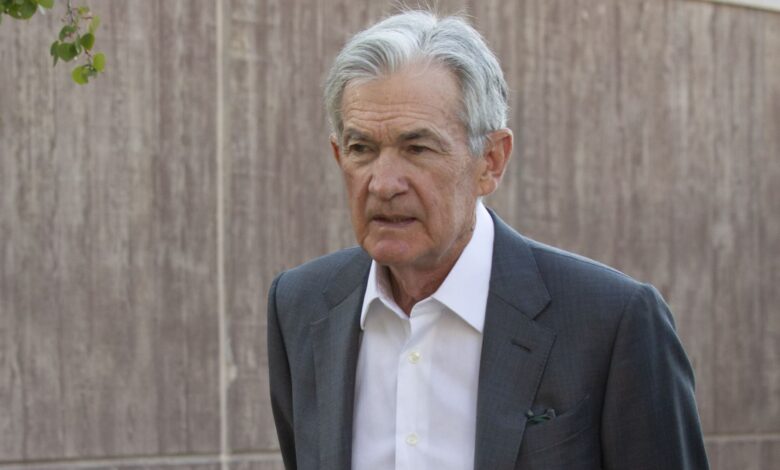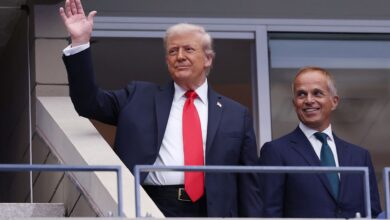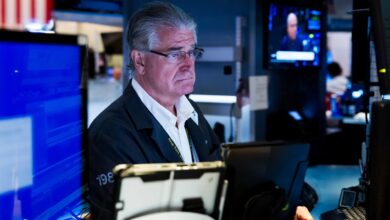Markets are now wondering whether the Fed might cut by half a point in September

With Federal Reserve Chair Jerome Powell all but confirming that an interest rate cut is imminent, the market’s attention Friday quickly turned to when and by how much. Traders continued to price in a greater likelihood that the Fed will kick off what is expected to be a protracted easing campaign in September with a quarter percentage point, or 25 basis point, reduction. However, the odds of something even more aggressive, like a half-point move, grew quickly and were around a 1-in-3 chance of happening, according to pricing in the 30-day fed funds futures market as measured by the CME Group’s FedWatch . Market participants see the chance as particularly likely should the August jobs report — to be released Sept. 6 — prove a repeat of the weaker-than-expected reading in July . The Fed’s next meeting kicks off less than two weeks later, on Sept. 17. “My base-case scenario is that we are on a journey of 25 basis point cuts, probably for the next eight meetings, a couple hundred basis points cumulative,” economist Paul McCulley said on CNBC’s ” Squawk on the Street .” “But if we see weaker growth, and particularly weaker jobs, then I think we could have a bit of front-loading and start the process with 50 basis point cuts.” “I don’t think that’s the base case yet, but clearly he’s opened the door for front-loading of the easing process, just like he had front-loading of the tightening process,” added McCulley, a former managing director at Pimco and now a senior fellow at Cornell and adjunct professor at Georgetown. Powell’s much-anticipated speech at the Fed’s annual symposium in Jackson Hole, Wyoming, provided clear indications that a rate cut is in the cards. “The time has come for policy to adjust,” the central bank leader said. The case for cutting half a point However, he was less direct about the timing and pace of the cuts, leaving the market to guess just how much the Powell Fed is prepared to ease. Several of the chair’s statements, though, seemed to indicate a bias toward swifter action, particularly if the jobs picture continues to weaken. “We do not seek or welcome further cooling in labor market conditions,” Powell said. That, among other vows to support the economy now that inflation has waned, provided some indication that a 50 basis point move is at least on the table. The Fed’s benchmark borrowing rate, which influences a bulk of other rates that consumers pay, is now targeted in a range between 5.25%-5.5%. Markets expect the central bank to knock off a full percentage point this year and at least that much in 2025. “It just seems to me, the Fed gets more optionality by doing 50,” said Joseph LaVorgna, chief economist at SMBC Nikko Securities. “If you mapped out what you thought would be 25-25-25 in September, November and December, why wouldn’t you just do a 50 to start with? You know you’ve got to get rates lower. If things turn out to be better, that’s fine. Why would you wait?” Jobs report key In separate CNBC interviews Friday, regional Presidents Raphael Bostic of Atlanta and Austan Goolsbee of Chicago did not commit to a particular easing strategy, though they indicated that cuts are coming. “The numbers are starting to move in a direction which suggests that our policy has had its effect, and we can start the pathway to [return] back to a normal policy posture,” Bostic said. “Look, we can’t wait until inflation is at 2% itself to start moving. Inflation has come way down, so that tells me that we have to really think hard about that.” Attention now turns to the August jobs report due in two weeks. Another weak reading like July, which saw job gains of just 114,000 and an increase in the unemployment rate to 4.3%, could well trigger the Fed to approve a half-point increase. Conversely, indications that the labor market strengthened would be unlikely to stop the Fed from cutting, but would virtually assure a quarter-point move. Powell’s comment that the “direction of travel is clear” both signaled a rate cut and that “the door was open to moving 50 bps to move the Funds rates closer to a level that is still restrictive relative to today’s economic and inflationary conditions,” Rick Rieder, CIO of BlackRock’s global fixed income team, said in a note to clients. “We think the Fed should get policy rates down to a 4% Funds rate more quickly as it would be more in line with current economic and inflationary conditions, which would call for 50 bps moves over the next couple of meetings,” he added. “The data would have to open the door for that in the current Fed’s thinking.” Correction: Austan Goolsbee is president of the Federal Reserve Bank of Chicago. An earlier version misstated the location.




